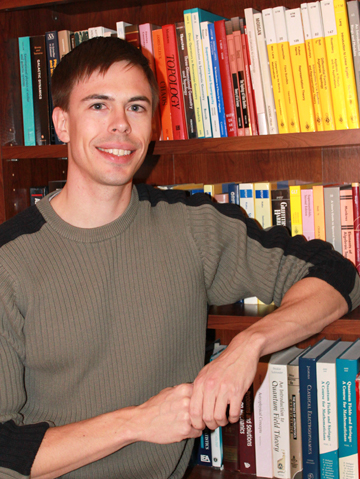Purdue Profiles: Aaron Warren

Aaron Warren, associate professor of physics at Purdue North Central. (Photo provided)
From physics to astronomy to sundials, all of Aaron Warren's interests have one underlying theme -- a palpable enthusiasm for scientific inquiry. Warren, associate professor of physics at Purdue North Central, played an integral role in acquiring PNC's only public sundial from the North American Sundial Society in 2009. He is also an advisor for the Purdue North Central Astronomy Club.
Though he has many interests, Warren's true passion is in his research. By characterizing information flow and learning, Warren is devising ways to evolve physics education.
When did physics become interesting to you? What about this area of study drew you to it?
The earliest event I remember was when I was 6 and my parents gave me a book about astronomy. Reading it was an eye-opening experience. The book introduced me to the notion that just a few properties and rules may explain all the structure that we see.
As I grew older, I chose to pursue physics, math and astronomy since those are the most fundamental disciplines, in the reductionist sense. I felt that if I could study those I would have the cognitive tools needed to investigate other subjects. There is nothing I enjoy more than learning something new, and I've found that physics, math and astronomy are excellent at enabling learning across a wide variety of subjects.
What drew you to Purdue North Central?
Coming out of grad school, I found it important that I have small classes and be able to develop a strong relationship with my students. My own undergraduate experience at Vassar College was tremendously positive in large part because the faculty provided a fantastic developmental environment for me. My professors were mentors and friends who cared about my development as both a student and person. I wanted to provide a similar sort of benefit for my own students. After visiting the PNC campus and meeting some of the faculty and students, I knew that PNC would be a terrific venue for that.
What does your research focus on?
I work primarily in physics education research. Over the last few years, my interest has focused more on the development of quantitative tools to characterize information flow and learning in physics courses. The two major tools I use are network analysis and time-series analysis.
I’ve used network analysis to characterize the interactions of students working in lab groups and to study how their interactions depend on both the nature of the lab activity as well as the intrinsic properties of the students. I’ve used time-series analysis with my collaborators, Andrew Heckler at Ohio State University and Thomas Scaife at University of Wisconsin-Platteville, to model the evolution of student conceptual understanding during introductory physics courses.
Why did you decide to focus on information flow and learning in physics classes?
My interest here stems from my own love of learning and scientific analysis. As a student, I was always trying to improve and expand my learning and problem-solving strategies in order to cope with an ever widening range of situations. When I was in graduate school working in string theory, although the research was fascinating, I felt it was too far removed from the "real world" for my taste.
I was intrigued when I heard that there was a community of physicists conducting multidisciplinary research in education. Learning is a complex and fundamentally important activity, so an attempt to model the learning process and then engineer ways to improve it seemed like a productive and exciting endeavor.
You were integral in the acquisition of PNC's first sundial in 2009. What about sundials interested you?
The study of sundials involves history, mathematics, engineering and astronomy. This multifaceted nature makes it an interesting topic to explore. Though it's certainly not important as a timekeeper anymore, especially with the prevalence of cell phones and smartphones, I think the sundial is important because it may give people reason to consider how it is possible to create such a device. To me, a sundial serves three purposes -- a reminder of how far we have come as a species, a reflection on how that journey has been made and a challenge to consider how our journey can yet be improved.
